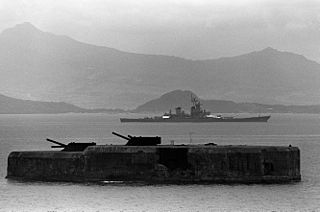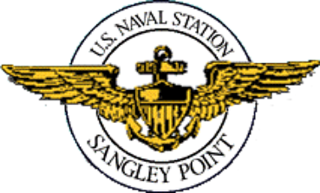 W
WBattery Way was a battery of four 12-inch mortars located on the island of Corregidor. Battery Way was one of two mortar batteries at Fort Mills that, with Fort Hughes, Fort Drum, Fort Frank and Fort Wint formed the Harbor Defenses of Manila and Subic Bays. Battery Way was named for Lt. Henry N. Way of the 4th U.S. Artillery.
 W
WNaval Station Pascual Ledesma, also known as Cavite Naval Base or Cavite Navy Yard, is a military installation of the Philippine Navy in Cavite City in the Province of Cavite. In the ‘40s and ‘50s, it was called Philippine Navy Operating Base. The 9-hectare (22-acre) naval base is located at the easternmost end of Cavite Point in the San Roque district of the city. Via traffic lane, this naval establishment is next to the famous Samonte Park. It was the former extension of U.S. Naval Station Sangley Point today’s Naval Station Heracleo Alano, transferred to the Philippines in 1971. In 2009 it was named after Cmdre. Pascual Ledesma, a leader of the Philippine revolution and the first Officer-In-Command of the Philippine Navy.
 W
WCorregidor Island is an island located at the entrance of Manila Bay in southwestern part of Luzon Island in the Philippines. Due to this location, Corregidor has historically been fortified with coastal artillery to defend the entrance of Manila Bay and Manila from attacks by enemy warships. Located 48 kilometres (30 mi) inland, Manila has been the largest city and the most important seaport in the Philippines for centuries, from the colonial rule of Spain, Japan and the United States, to the establishment of the Philippines in 1946.
 W
WDanilo Atienza Air Base is a military base used by the Philippine Air Force, located on the northern end of Cavite Peninsula in Manila Bay, Luzon Island, the Philippines. It is adjacent to Cavite City, in Cavite Province.
 W
WFort Drum, also known as "the concrete battleship", is a heavily fortified island situated at the mouth of Manila Bay in the Philippines, due south of Corregidor Island. The reinforced concrete sea fort shaped like a battleship was built by the United States in 1909 as one of the harbor defenses at the wider South Channel entrance to the bay during the American colonial period.
 W
WFort San Felipe is a military fortress in Cavite City, in the Province of Cavite, Philippines. It was constructed by the Spanish military in 1609 in the first port town of Cavite, the historic core of the present and larger Cavite City, for its protection. Less than half of the original historic structure survives today. The remaining structure is made of granite blocks with 30-foot high walls and features a wide stairway leading to the top of the bastions and remaining walls. Naval memorabilia including antique cannons and cannonballs decorate the lawns of the fortification. Fort San Felipe is located within the 9-hectare (22-acre) Naval Base Cavite of the Philippine Navy and is not open to the public.
 W
WFort Frank was one of the defense forts at the entrance to Manila Bay established by the United States. The entire island was designated as Fort Frank, in honor of Brigadier General Royal T. Frank, as part of the Harbor Defenses of Manila and Subic Bays built by the Philippine Department of the US Army in the early 1900s.
 W
WFort Hughes was part of the Harbor Defenses of Manila and Subic Bays built by the Philippine Department of the U.S. Army in the early 1900s. The fort was named for Major General Robert P. Hughes, a veteran of the American Civil War, Spanish–American War, and the Philippine–American War.
 W
WThe Malinta Tunnel is a tunnel complex built by the United States Army Corps of Engineers on the island of Corregidor in the Philippines. It was initially used as a bomb-proof storage and personnel bunker, but was later equipped as a 1,000-bed hospital. The main tunnel, running east to west, is 831 feet (253 m) long, 24 feet (7.3 m) wide and 18 feet (5.5 m) high. Branching off from this main shaft are 13 lateral tunnels on the north side and 11 lateral tunnels on the south side. Each lateral averaged 160 feet (49 m) in length and 15 feet (4.6 m) in width.
 W
WFort Mills was the location of US Major General George F. Moore's headquarters for the Philippine Department's Harbor Defenses of Manila and Subic Bays in early World War II, and was the largest seacoast fort in the Philippines. Most of this Coast Artillery Corps fort was built 1904–1910 by the United States Army Corps of Engineers as part of the Taft program of seacoast defense. The fort was named for Brigadier General Samuel Meyers Mills Jr., Chief of Artillery 1905–1906. It was the primary location of the Battle of Corregidor in the Japanese invasion of the Philippines in 1941–42, and of the recapture of Corregidor in February 1945, both in World War II.
 W
WNaval Station Pascual Ledesma, also known as Cavite Naval Base or Cavite Navy Yard, is a military installation of the Philippine Navy in Cavite City in the Province of Cavite. In the ‘40s and ‘50s, it was called Philippine Navy Operating Base. The 9-hectare (22-acre) naval base is located at the easternmost end of Cavite Point in the San Roque district of the city. Via traffic lane, this naval establishment is next to the famous Samonte Park. It was the former extension of U.S. Naval Station Sangley Point today’s Naval Station Heracleo Alano, transferred to the Philippines in 1971. In 2009 it was named after Cmdre. Pascual Ledesma, a leader of the Philippine revolution and the first Officer-In-Command of the Philippine Navy.
 W
WNaval Station Sangley Point was a communication and hospital facility of the United States Navy which occupied the northern portion of the Cavite City peninsula and is surrounded by Manila Bay, approximately eight miles southwest of Manila, the Philippines. The station was a part of the Cavite Navy Yard across the peninsula. The naval station had a runway that was built after World War II, which was used by U.S. Navy Lockheed P-2 Neptune, Lockheed P-3 Orion, and Martin P4M Mercator maritime patrol and anti-submarine warfare aircraft. An adjacent seaplane runway, ramp area and seaplane tender berths also supported Martin P5M Marlin maritime patrol aircraft until that type's retirement from active naval service in the late 1960s. NAS Sangley Point/NAVSTA Sangley Point was also used extensively during the Vietnam War, primarily for U.S. Navy patrol squadrons forward deployed from the United States on six-month rotations. The naval station was turned over to the Philippine government in 1971. It is now operated by the Philippine Air Force and Philippine Navy.